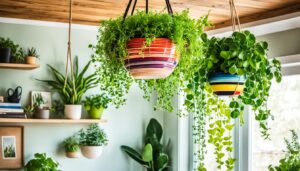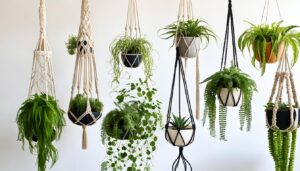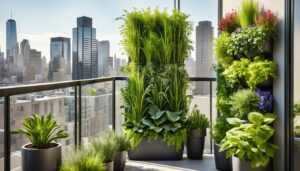Introduction:
With urbanization dominating landscapes and green spaces, there’s a growing trend towards bringing nature indoors. One delightful way to do so is by crafting your own terrarium. These miniature ecosystems bring the beauty of nature within glass walls, offering a captivating glimpse of verdant landscapes in the confines of your home or office.
Terrariums, with their diverse array of plants and self-sustaining environments, have garnered popularity not only for their aesthetic appeal but also for their ease of maintenance. Whether you’re a seasoned green thumb or a novice gardener, creating a terrarium is an accessible and rewarding activity which can be done easily and quickly. The end result can invigorate any space with a touch of greenery and personality.
In this guide, we’ll delve into the art of terrarium-making, from selecting the right container to choosing suitable plants and maintaining your miniature oasis. Whether you’re seeking to enliven a dreary corner or add a dash of nature to your workspace, crafting your own terrarium offers a creative outlet and a connection to the natural world, right at your fingertips. So roll up your sleeves, gather your materials, and let’s embark on a journey to create your very own botanical masterpiece.
Selecting the Perfect Container
When it comes to creating a terrarium, the container you choose sets the stage for the entire composition. While traditional terrariums are often housed in glass vessels, the possibilities are endless, ranging from vintage jars and geometric glass containers to open bowls and even repurposed fish tanks. Here are some key considerations to keep in mind when selecting the perfect container for your terrarium:
- Size Matters: The size of your container will dictate the scale of your terrarium and the number of plants it can accommodate. Opt for a container that provides ample space for your chosen plants to thrive without overcrowding.
- Shape and Style: From sleek cylinders to whimsical teardrops, the shape and style of your container can greatly influence the overall aesthetic of your terrarium. Consider the vibe you wish to evoke – whether it’s modern and minimalist or rustic and eclectic – and select a container that complements your vision.
- Transparency: Glass containers offer a clear view of the lush greenery within, allowing you to admire the intricate details of your miniature landscape. However, opaque containers can also lend a sense of mystery, especially when paired with strategic lighting.
- Accessibility: Choose a container with a wide enough opening to facilitate planting and maintenance. Narrow-necked vessels may pose challenges when it comes to arranging plants and watering, so opt for containers with easy access.
- Drainage: While drainage holes are essential for traditional plant pots, terrariums operate on a closed system, requiring minimal drainage. However, it’s still important to provide adequate airflow to prevent moisture buildup and maintain optimal growing conditions.
To help you narrow down your options, here’s a handy checklist to guide you through the process of selecting the perfect container for your terrarium:
Consideration | Criteria |
Size | Choose a container that provides ample space for your plants. |
Shape and Style | Consider the aesthetic you wish to achieve. |
Transparency | Decide whether you prefer a clear or opaque container. |
Accessibility | Ensure easy access for planting and maintenance. |
Drainage | Opt for containers that promote airflow and prevent moisture buildup. |
Selecting Suitable Plants
With your container in hand, the next step in creating a captivating terrarium is selecting the perfect plants to inhabit your miniature ecosystem. When choosing plants for your terrarium, it’s essential to consider factors such as size, light requirements, and humidity tolerance. Here’s a guide to help you select suitable plants for your terrarium:
- Size and Scale: Opt for plants that will fit comfortably within the confines of your container without overcrowding. Choose a variety of sizes to create visual interest, with taller plants serving as focal points and smaller ones adding texture and depth.
- Light Requirements: Assess the lighting conditions in the location where you plan to place your terrarium and select plants that thrive in those conditions. While most terrariums prefer bright, indirect light, some plants may require more or less sunlight. Here are some common light requirements for terrarium plants:
- Low Light: Ideal for terrariums placed in dimly lit areas or away from direct sunlight. Suitable plants include ferns, mosses, and snake plants.
- Medium Light: Perfect for terrariums positioned in bright, indirect light. Consider plants like fittonias, nerve plants, and peperomias.
- Bright Light: Suitable for terrariums located in sunny spots with ample natural light. Choose plants such as succulents, air plants, and cacti.
- Humidity Tolerance: Terrariums create a humid microclimate that may not be suitable for all plants. Select species that can thrive in high humidity environments, such as tropical plants and moisture-loving ferns.
- Variety and Texture: Incorporate a mix of foliage types to add visual interest to your terrarium. Combine different shapes, colors, and textures to create a dynamic and harmonious composition.
To simplify the plant selection process, here’s a checklist of considerations to keep in mind:
Consideration | Criteria |
Size and Scale | Choose plants that fit your container and provide visual interest. |
Light Requirements | Select plants based on the available light in your space. |
Humidity Tolerance | Ensure plants can thrive in the humid environment of a terrarium. |
Variety and Texture | Incorporate a mix of foliage types for a dynamic composition. |
Designing and Planting Your Terrarium
Now that you’ve selected the perfect container and chosen suitable plants, it’s time to bring your terrarium to life through thoughtful design and strategic planting. Creating a visually appealing arrangement not only enhances the aesthetic appeal of your terrarium but also ensures optimal growing conditions for your plants. Here’s a step-by-step guide to designing and planting your terrarium:
- Layering Substrates: Start by creating a foundation for your terrarium with a layer of drainage material at the bottom. This can be achieved using small pebbles, activated charcoal, or gravel, which help prevent waterlogging and maintain proper airflow within the container. On top of the drainage layer, add a thin layer of sphagnum moss to act as a barrier between the drainage material and the growing medium.
- Adding Growing Medium: Next, add a layer of potting mix specifically formulated for terrariums. This lightweight and well-draining medium provide essential nutrients for plant growth while retaining moisture to create a humid environment. Aim for a depth of 1-2 inches, ensuring there’s enough room for plant roots to spread and grow.
- Arranging Plants: Before planting, arrange your chosen plants within the terrarium to determine their placement and ensure a balanced composition. Consider factors such as height, color, and texture when arranging your plants, aiming for a harmonious balance of foliage types and shapes. Use taller plants as focal points and fill in the gaps with smaller varieties for a layered effect.
- Planting Technique: Once you’re satisfied with the arrangement, carefully remove plants from their pots and gently loosen the roots to encourage healthy growth. Dig small holes in the growing medium and place each plant in its designated spot, ensuring the roots are covered and firmly pressed into the soil. Use a small brush or chopstick to adjust plant positioning and remove any air pockets around the roots.
- Adding Decorative Elements: Enhance the visual appeal of your terrarium by incorporating decorative elements such as rocks, driftwood, or figurines. These accents not only add personality to your creation but also provide additional texture and interest. Arrange them strategically throughout the terrarium, taking care not to overcrowd the space or obstruct plant growth.
To guide you through the design and planting process, here’s a checklist of steps to follow:
Step | Description |
Layering Substrates | Create a foundation with drainage material and sphagnum moss. |
Adding Growing Medium | Add a layer of terrarium-specific potting mix for plant growth. |
Arranging Plants | Arrange plants to achieve a balanced and visually appealing composition. |
Planting Technique | Carefully plant each specimen, ensuring proper root coverage and positioning. |
Adding Decorative Elements | Enhance the terrarium with rocks, driftwood, or other decorative accents. |
Caring for Your Terrarium
Congratulations on successfully designing and planting your terrarium! Now that your miniature ecosystem is in place, it’s time to shift your focus to care and maintenance to ensure the long-term health and vitality of your plants. Proper care is essential for sustaining the delicate balance of moisture, light, and nutrients within your terrarium. Here’s a comprehensive guide to caring for your terrarium:
- Watering: Proper watering is crucial for the health of your terrarium plants. Unlike traditional houseplants, terrariums require minimal watering due to their enclosed environment. Overwatering can lead to root rot and fungal growth, while underwatering can result in dry, wilted plants. Monitor the moisture level of the growing medium and water only when necessary. A good rule of thumb is to water sparingly, allowing the soil to dry out slightly between waterings. Use a spray bottle or watering can with a narrow spout to target water directly at the base of the plants, avoiding excess moisture on foliage and glass walls.
- Lighting: Place your terrarium in a location with indirect sunlight or bright, filtered light. Avoid placing it in direct sunlight, as this can cause excessive heat and scorch delicate foliage. Rotate your terrarium periodically to ensure all plants receive uniform light exposure and prevent uneven growth. If natural light is insufficient, supplement with artificial grow lights specifically designed for indoor plants.
- Pruning and Maintenance: Regular maintenance is essential for keeping your terrarium looking its best. Remove any dead or yellowing foliage, as well as any debris that may accumulate on the soil surface. Prune overgrown plants to maintain a balanced and visually appealing arrangement. Check for signs of pests or disease and address any issues promptly to prevent spread.
- Fertilizing: While terrariums typically require minimal fertilization due to the recycling of nutrients within the enclosed environment, occasional feeding can help promote healthy growth. Use a diluted liquid fertilizer formulated for houseplants and apply sparingly according to package instructions. Avoid overfertilizing, as this can lead to nutrient imbalances and damage to plant roots.
- Monitoring Humidity: Terrariums create a humid microclimate that is ideal for tropical plants. Monitor humidity levels within the terrarium and adjust ventilation as needed to prevent excessive moisture buildup. If condensation accumulates on the glass walls, temporarily remove the lid to allow excess moisture to evaporate, then replace once humidity levels have stabilized.
To help you stay on track with terrarium care, here’s a checklist of essential tasks to incorporate into your routine:
Task | Description |
Watering | Monitor moisture levels and water sparingly as needed. |
Lighting | Place terrarium in a location with indirect sunlight or artificial grow lights. |
Pruning and Maintenance | Remove dead foliage, debris, and pests, and prune overgrown plants. |
Fertilizing | Feed plants occasionally with a diluted liquid fertilizer. |
Monitoring Humidity | Check humidity levels and adjust ventilation to maintain optimal conditions. |
Troubleshooting Common Issues
While terrariums are relatively low-maintenance, they may encounter occasional challenges that require attention and intervention. From overwatering to pest infestations, addressing these issues promptly is essential for maintaining the health and vitality of your miniature ecosystem. Here’s a guide to troubleshooting common problems encountered with terrariums:
- Overwatering: One of the most common mistakes made with terrariums is overwatering. Excessive moisture can lead to waterlogged soil, root rot, and fungal infections. If you notice water pooling at the bottom of your terrarium or if the soil feels consistently damp, it’s a sign that you may be overwatering. To remedy this issue, reduce watering frequency and allow the soil to dry out between waterings. Increase ventilation within the terrarium to promote evaporation and prevent moisture buildup.
- Underwatering: On the flip side, underwatering can also pose problems for terrarium plants, causing wilting, yellowing foliage, and stunted growth. If the soil feels dry to the touch or if plants appear wilted, it’s a sign that they may need more water. Increase watering frequency and ensure thorough saturation of the soil, taking care not to overwater in the process.
- Fungal Growth: Excessive moisture and poor ventilation can create an ideal environment for fungal growth within the terrarium. If you notice fuzzy white mold or mushrooms growing on the soil surface, it’s a sign of fungal infection. Remove affected plants and soil immediately, and increase ventilation within the terrarium to discourage further fungal growth. Consider replacing the soil and adjusting watering practices to prevent recurrence.
- Pest Infestations: Terrariums are not immune to pest infestations, with common culprits including aphids, mealybugs, and spider mites. If you notice small insects or webs on plant foliage, it’s a sign of pest activity. Remove affected plants and inspect them thoroughly for signs of pests. Treat infested plants with insecticidal soap or neem oil, and isolate them from healthy specimens to prevent spread.
- Yellowing or Dropping Leaves: Yellowing or dropping leaves can be indicative of various issues, including nutrient deficiencies, overwatering, or inadequate light. Assess environmental conditions within the terrarium and address any underlying issues accordingly. Adjust watering practices, provide supplemental lighting if needed, and consider feeding plants with a balanced liquid fertilizer to correct nutrient imbalances.
To help you troubleshoot common issues with your terrarium, here’s a checklist of potential problems and their solutions:
Issue | Symptoms | Solution |
Overwatering | Water pooling, damp soil | Reduce watering frequency, increase ventilation. |
Underwatering | Dry soil, wilting foliage | Increase watering frequency, ensure thorough saturation of soil. |
Fungal Growth | White mold, mushrooms | Remove affected plants and soil, increase ventilation. |
Pest Infestations | Insects, webs on foliage | Treat with insecticidal soap or neem oil, isolate affected plants. |
Yellowing or Dropping Leaves | Yellowing or dropping foliage | Assess environmental conditions, adjust care accordingly. |
In conclusion, crafting your own terrarium offers not only a creative outlet but also a rewarding journey into the world of indoor gardening. Throughout this beginner’s guide, we’ve explored the essential steps involved in terrarium-making, from selecting the perfect container to caring for your miniature ecosystem. By embracing terrariums, you can bring the beauty of nature into your indoor space, regardless of your gardening experience or the size of your living area.
Terrariums provide a unique opportunity to experiment with plant selection, design, and display, allowing you to express your creativity and personalize your living environment. Whether you choose to create a lush tropical jungle, an arid desert landscape, or a whimsical fairy garden, the possibilities are limited only by your imagination.
As you embark on your terrarium-making journey, remember to start small and gradually expand your skills and knowledge. Pay attention to the needs of your plants, adjust care routines as necessary, and don’t be afraid to experiment with different designs and techniques. With patience, dedication, and a little bit of green-thumb magic, you can create stunning terrariums that bring joy and tranquility to your home or office for years to come.
I hope you have enjoyed this look at the creative and rewarding world of Terrarium Design and creation’ If you would like to see more information like this and many other gardening pursuits please consider checking us out at The Landscape Connection and get on the mailing list that gets you newsletters and topics that Michelle develops that are really popular and fun!





Pingback: 16 Must-Know Houseplant Trends for 2025 – What's Hot This Year? - Trusted House Plant Guide